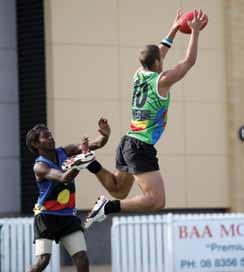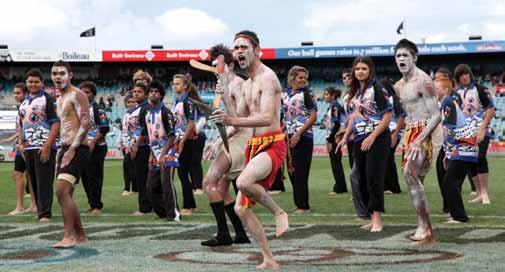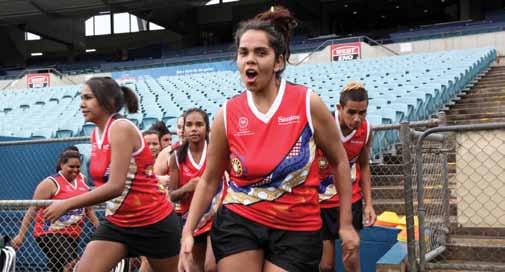
9 minute read
Mabo still brings hope after 20 years
paper tracker
The Anangu Lands Paper Tracker is an online project of Uniting Care Wesley, Adelaide.
Advertisement
The website tracks government commitments to Anangu (Pitjantjatjara and Yankunytjatjara people). It publishes accurate, up-to-date information on projects and services that are important to Anangu.
The Paper Tracker aims to make it easier for Anangu to work with governments as equal partners. It helps Anangu make sure governments are following through on commitments.
Aboriginal Way will assist Paper Tracker by highlighting some of the issues it is following.
If you want more information on any of these items log on to www.papertracker.com.au
Opal fuel: mandating its supply in certain locations
The invention and rollout of Opal fuel led to a “dramatic and sustained decline” in petrol sniffing numbers in many Anangu communities. However, some roadhouses close to Anangu lands – including at least two in South Australia – have steadfastly refused to stock this new fuel. Their intransigence has frustrated the comprehensive rollout of Opal fuel across a large part of Central Australia. On 1 March 2012, a Bill to “promote the supply” of Opal fuel and “control the supply of other fuels in certain areas” was introduced into Federal Parliament. The South Australian Government does not support the proposed legislation as it considers “voluntary arrangements are sufficient at this time.
On 11 May 2012, the Paper Tracker highlighted its strong support for the Low Aromatic Fuel Bill 2012 in a letter to the South Australian Minister for Mental Health and Substance Abuse (Hon John Hill MP). In the same letter, we expressed interest in knowing if the South Australian Government supported “the proposed federal legislation and if not, why not.” We also asked the Minister for information on any action the Government had taken or will be taking this year to ensure Opal fuel replaces standard unleaded fuel in those South Australian roadhouses that the Federal Department of Health and Ageing has identified as sites where Opal fuel should be sold.
In a reply dated 25 June 2012, Minister Hill advised the Paper Tracker that in his view the Federal Government’s existing approach of encouraging retail sites to voluntarily sell and supply Opal fuel had been “very successful” and that “further action at the State level” was not required “at this time.”
The Paper Tracker will continue to monitor this issue.
APY Lands: review of staff housing
In mid 2010, the South Australian Government commenced a review of “staff housing needs” on the APY Lands to, among other things, “explore opportunities for agencies to share housing so that the existing stock can be used more effectively.” The Government originally expected the review to be completed by October 2010. This timeframe was not met.
On 2 April 2012, the Government reported that it was currently considering “the need for a new policy framework for government housing and for the management of overnight visitor accommodation so as to improve co-ordination and access” on the APY Lands.
APY Lands: funding for art centre infrastructure
In September 2011, the Australian Government provided $2.84 million towards the costs of building and upgrading art centre infrastructure in six APY communities.
All of these works are expected to be completed by mid 2013. On 13 February 2012, Ananguku Arts advised the Paper Tracker that the Australian Government’s funding would be used for the following developments: Iwantja Arts: the construction of a new men’s painting room and the refurbishment of the existing art centre; Mimili Maku: the construction of new men’s and women’s painting rooms, an office and a wet area;
Kaltjiti Arts: the construction of a new men’s painting room and the re-roofing and refurbishment of the existing painting area; Ernabella Arts (Pukatja): the construction of a new men’s painting room, the refurbishment of the office and the replacement of a septic/plumbing; Tjala Arts (Amata): the construction of an archives room; and Ninuku Arts (Kalka): the construction of a new painting room. Ananguku Arts also indicated that a steering committee had been established to oversee the project and that it was aiming to have all of the work completed by 31 July 2013. The Paper Tracker has congratulated the Australian Government on its decision to fund these and other important improvements to art centre infrastructure on the APY Lands.
Pukatja: access to the internet
Data from last year’s census has confirmed Pukatja’s status as South Australia’s largest remote Aboriginal community. It has also revealed an alarming digital divide. Whereas over 90% of the non-Indigenous households in Pukatja have internet access at home; not a single Anangu household (0%) has internet access at home. This census data underscores the need for governments to establish free public internet access somewhere in Pukatja.
The matters listed above are just a sample of the types of issues being followed by Paper Tracker. If you’d like to know more you can contact Paper Tracker on (08) 202 5867 or subscribe to their newsletter at www.papertracker.com.au
Mabo still brings hope af ter 20 years
The native title system remains challenging 20 years after Mabo but there’s still cause to be optimistic, according to Social Justice Commissioner Mick Gooda.
Commissioner Gooda said Mabo’s recognition that terra nullius was a myth was a defining moment for Aboriginal and Torres Strait Islander people. “Mabo was also a moment that divided the Australian community, with the mining industry and some state governments particularly strident in their opposition, fuelled in no small part by headlines peddling ill-founded fears that the humble backyard would soon be swallowed up by Aboriginal and Torres Strait land claims,” Commissioner Gooda said.
“But Eddie Mabo’s victory represented so much more than an argument about land rights.
“As Professor Mick Dodson observed in 1994, the ‘recognition of native title was more than a recognition of Indigenous property interests, it is also about the recognition of our human rights,’” he said.
“Native title was – and is – a promise to recognise Aboriginal and Torres Strait Islander people’s traditional connection to, and rights and interests in, their lands, territories and resources. “The process of recognising native title itself has been frustrating, bringing hope and expectation of the return of country on the one hand, but opening up tensions and wounds around connections to country, family histories and community relationships on the other hand,” he said. “Despite all this, I am optimistic that the original promise of the Mabo decision can still be realised.”
Mr Gooda said amendments introduced into Parliament in February this year are being considered within the context of Australian government support for the United Nations Declaration on the Rights of Indigenous Peoples. The Declaration provides that States are to establish and implement ‘a fair, independent, impartial, open and transparent process … to recognise and adjudicate the rights of indigenous peoples pertaining to their lands, territories and resources’.
“The Declaration requires us to go further than merely tinkering at the edges of native title reform,” he said. “This reform Bill is a big step in the right direction but we need to go much further to ensure that the Native Title Act is consistent with the Declaration in upholding the human rights of Aboriginal and Torres Strait Islander people.”
SOUTH AUSTRALIAN NATIVE TITLE SERVICES
Level 4 345 King William Street ADELAIDE SA 5000
Editor Keith Thomas
Journalist Lesley Johns
Advertising Enquiries (08) 8110 2800
Circulation 10,000
If you have any stories of interest to our readers, please address any correspondence to: editor@nativetitlesa.org
Aboriginal Way South Australian Native Title Services Level 4 345 King William Street ADELAIDE SA 5000 Ph: 8110 2800 Fax: 8110 2811 FREECALL: 1800 010 360
The Editor has the final decision on all stories and advertising that appear in this publication.
Power Cup once again outstanding success
The Aboriginal Power Cup Grand Final boys competition was taken out by Salisbury High School (11.8.74) who played Murray Bridge High School (8.9.57), and the girls competition by Murray Bridge High School (7.9.51) who played Salisbury High School (3.5.23). 36 boys and girls realised their dream of playing football at AAMI Stadium which was made even more special as a curtain raiser to the Power’s AFL Indigenous Round clash with North Melbourne. Minister for Aboriginal Affairs and Reconciliation Paul Caica said the Grand Final was the culmination of dozens of competitive football games, played by around 300 students from 25 school sites, held at Alberton Oval last Thursday and Friday. “The commitment, efforts and enthusiasm of this year’s students has made the 2012 Aboriginal Power Cup particularly special and fitting as we celebrated the five year anniversary of the program, with it aligned to the AFL’s Indigenous Round for the first time,” Minister Caica said. “The State Government is a proud supporter of this initiative that encourages Aboriginal students tostay in school and attain their SACE along with developing pathways for further education or employment that will help them to lead positive and healthy lives.” Port Adelaide Football Club Chief Executive Keith Thomas said “Port Adelaide as a Football Club is committed to giving back to the community and developing young Aboriginal students’ skills both on and off the football field. “In addition to participating in the football carnival, students were awarded points for completing their school curriculum tasks over terms one and two as part of the SACE-accredited Aboriginal Power Cup subject. The school work was a critical part in determining which teams played in the Grand Final games at AAMI Stadium on Saturday.” Santos Vice President Eastern Australia James Baulderstone said “Our aim is to help young Aboriginal people reach their full potential by talking to them about their career dreams and then putting in place some training and employment opportunities at Santos to help them pursue them.” In addition to the Grand Final winners, several awards were handed out to teams who stood out over the carnival weekend and throughout the 2012 program. The Aboriginal Power Cup is a partnership between the State Government, Santos and Power Community Ltd, the community development arm of Port Adelaide Football Club.
It encourages Aboriginal secondary school students to continue with their education or training andforge career pathways through an innovative curriculum mix involving cultural activities, teamwork, life skills, healthy eating, physical activity, leadership and creative design.



Top left: Auntie Josie Agius, Kaurna Elder, at Alberton Oval. Top right: A player from the combined team of Roma Mitchell Secondary, Valley View Secondary, and Para Hills High takes a mark. (other player: Windsor Gardens Vocational College). Middle: Closing performance by the Kuma Kaaru dance group, led by Jack Buckskin. Bottom: Salisbury High School girls’ team take the field for the Grand Final. Photos simonmaiolo@gmail.com
Stay in touch
________________________________________________________ _________________________________ Postcode: _____________ Phone: __________________________________________________ Email: __________________________________________________ DX no: __________________________________________________ No of copies: ____________________________________________
Is this an alteration to our current records? Yes No
Would you like to be added to the mailing list? Yes No
Would you like to be sent regular information about SANTS? Yes No
ISSUE 49



